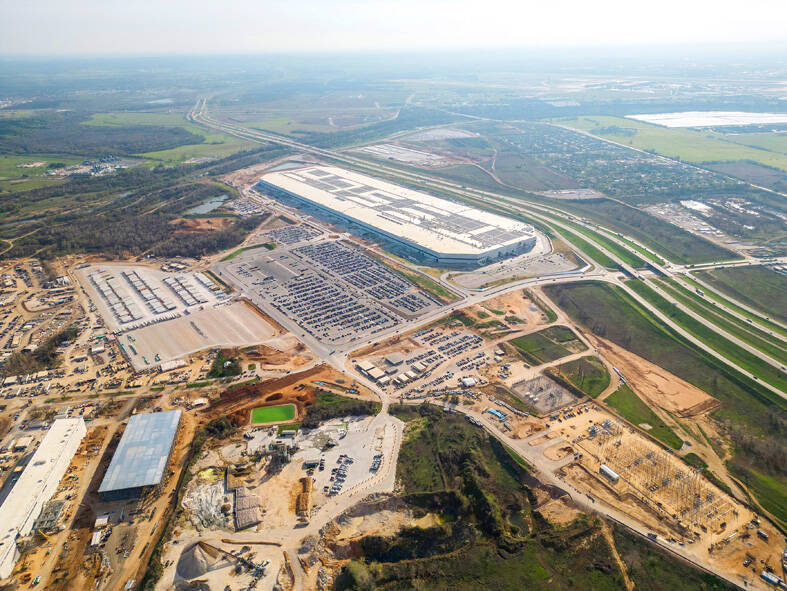US electric vehicle (EV) maker Tesla Inc is to invest about US$5 billion in a massive new factory in the northern Mexican city of Monterrey, a senior government official said on Tuesday.
The move, which had yet to be confirmed by Tesla, would be a major boost to Mexico’s hopes of benefiting from US companies choosing nearby countries over Asia for their manufacturing operations.
“We brought to Mexico an investment of more or less US$5 billion for the construction of the largest electric vehicle plant in the world,” Mexican Undersecretary for Multilateral Affairs and Human Rights Martha Delgado said in a video posted on Twitter.

Photo: Reuters
“I’m going to Austin, Texas, to witness the announcement @Telsa CEO @elonmusk will make about their investments in 2023,” she added in a text accompanying a video from Mexico City International Airport.
Earlier on Tuesday, Mexican President Andres Manuel Lopez Obrador announced that Tesla was going to open a plant in Monterrey, about 200km from the US border.
The factory was expected to be “very big” and would bring “a considerable investment and many jobs,” he said.
Lopez Obrador said Tesla would give more details yesterday, including addressing the problem of water scarcity in Monterrey, an industrial powerhouse home to transnational firms.
In discussions with Elon Musk, the Tesla CEO “was very receptive, understanding our concerns,” with measures expected to include the use of recycled water, the president said.
Mexico declared a drought emergency in July last year and authorities in parts of the country, including Monterrey, were forced to ration water use due to depleted reservoirs.
Tesla, which already has plants in China and Germany, as well as the US, was due to hold its Investor Day yesterday, live-streamed from its gigafactory in Texas.
Tesla faces increasing competition in the EV sector, with a growing number of Chinese makers, as well as traditional auto firms such as General Motors Co and Volkswagen AG.
Mexico sees its lithium deposits as central to its goal of playing a major role in the production of batteries for electric vehicles and other technology.
Last year, lawmakers approved a plan to put exploration and mining of the metal under state control.
The auto industry is already a key pillar of the Mexican economy — the second-largest in Latin America behind Brazil — home to US, European and Asian manufacturers.
Mexico is the world’s seventh-largest automobile producer, having produced 3 million vehicles in 2021, the latest available figures from the Mexican Automotive Industry Association showed.
The auto industry represented 3.5 percent of Mexico’s GDP and 930,000 jobs in 2021, with foreign investment in the sector amounting to US$5.3 billion that year, the association said.
German manufacturer BMW AG recently announced an investment of US$870 million to produce electric vehicles in Mexico.

The US dollar was trading at NT$29.7 at 10am today on the Taipei Foreign Exchange, as the New Taiwan dollar gained NT$1.364 from the previous close last week. The NT dollar continued to rise today, after surging 3.07 percent on Friday. After opening at NT$30.91, the NT dollar gained more than NT$1 in just 15 minutes, briefly passing the NT$30 mark. Before the US Department of the Treasury's semi-annual currency report came out, expectations that the NT dollar would keep rising were already building. The NT dollar on Friday closed at NT$31.064, up by NT$0.953 — a 3.07 percent single-day gain. Today,

‘SHORT TERM’: The local currency would likely remain strong in the near term, driven by anticipated US trade pressure, capital inflows and expectations of a US Fed rate cut The US dollar is expected to fall below NT$30 in the near term, as traders anticipate increased pressure from Washington for Taiwan to allow the New Taiwan dollar to appreciate, Cathay United Bank (國泰世華銀行) chief economist Lin Chi-chao (林啟超) said. Following a sharp drop in the greenback against the NT dollar on Friday, Lin told the Central News Agency that the local currency is likely to remain strong in the short term, driven in part by market psychology surrounding anticipated US policy pressure. On Friday, the US dollar fell NT$0.953, or 3.07 percent, closing at NT$31.064 — its lowest level since Jan.

Hong Kong authorities ramped up sales of the local dollar as the greenback’s slide threatened the foreign-exchange peg. The Hong Kong Monetary Authority (HKMA) sold a record HK$60.5 billion (US$7.8 billion) of the city’s currency, according to an alert sent on its Bloomberg page yesterday in Asia, after it tested the upper end of its trading band. That added to the HK$56.1 billion of sales versus the greenback since Friday. The rapid intervention signals efforts from the city’s authorities to limit the local currency’s moves within its HK$7.75 to HK$7.85 per US dollar trading band. Heavy sales of the local dollar by

The Financial Supervisory Commission (FSC) yesterday met with some of the nation’s largest insurance companies as a skyrocketing New Taiwan dollar piles pressure on their hundreds of billions of dollars in US bond investments. The commission has asked some life insurance firms, among the biggest Asian holders of US debt, to discuss how the rapidly strengthening NT dollar has impacted their operations, people familiar with the matter said. The meeting took place as the NT dollar jumped as much as 5 percent yesterday, its biggest intraday gain in more than three decades. The local currency surged as exporters rushed to